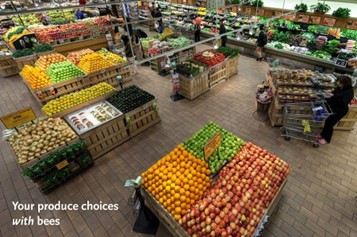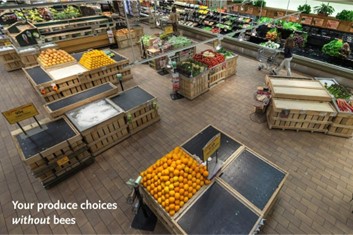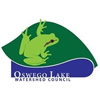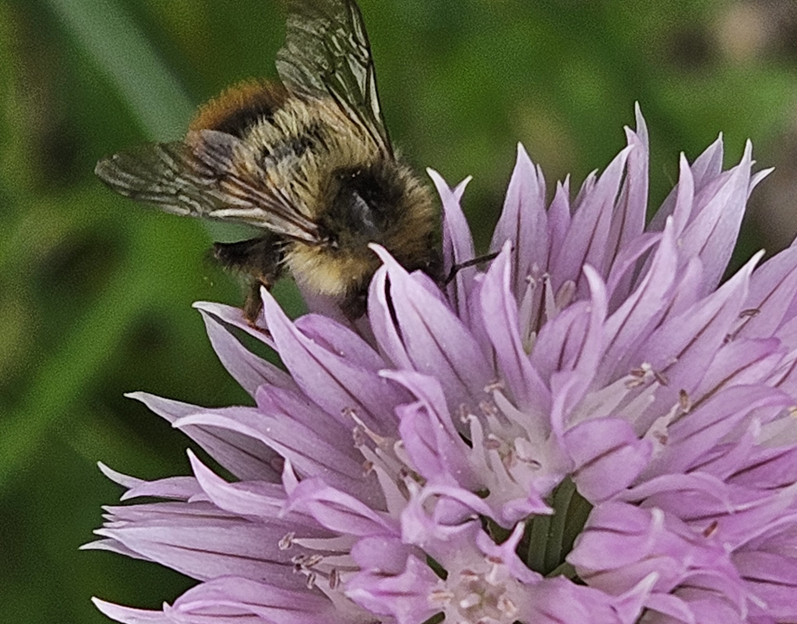You might remember these striking photographs showing the impact of pollinators on our food choices – these photos show the produce section of a Whole Foods market with, and without, fresh produce made available because of pollinators:
What is pollination?
Pollination occurs when pollen grains are transferred from one flower to another of the same species. Successful pollination results in healthy fruit and vegetables to eat, and fertile seeds. Without pollinators to visit flowering plants, we would not have many juicy and nutritious fruits and vegetables to eat! Over 85 percent of all flowering plants require pollinators to reproduce, and over two-thirds of our agricultural crops depend on pollinators. Not only do they pollinate our food crops, they are also vital for the survival of other wild plants that support birds and other wildlife.


What are pollinators?
Most people immediately think of honeybees as the most important pollinators, and indeed they are very important pollinators in current agricultural practice. Yet insect pollinators are an extremely diverse group. Many species of bee, wasp, fly, hoverfly, butterfly, moth and beetle also provide the essential service of pollination, to agricultural crops and to our native plants. Some plants are even pollinated by hummingbirds or bats.
Why do pollinators need our help?
Honeybees are an introduced species from Europe and are not native to our country. They are usually in hives tended by humans. Honeybees do, however, get a lot of publicity, and this helps to highlight the challenges that all pollinators face.
Up to 40% of native pollinators are at risk of becoming extinct in the coming years. They are also threatened because of the same factors that challenge honeybees, including pesticides, herbicides, climate change, loss of habitat, and diseases.
How You Can Help!
Join us for the OLWC Bee BioBlitz
Saturday, June 7th | 10:00 AM through
Sunday, June 8th | 5:00 PM
Researchers are monitoring pollinator populations to watch for species that could be in trouble and to assess threats to pollinators. Researchers also want to know what species are thriving. You can help by documenting what pollinators are present in your area, and if possible on what host plant.
Join us for the Bee BioBlitz, where community members will work together to observe and document local pollinators using the iNaturalist app. No prior experience needed—just bring your curiosity, a smartphone or camera, and a love for nature!
Kickoff Event: Meet us at Lake Oswego High School’s Outdoor Classroom at 10:00 AM on June 7th for an introduction to the BioBlitz, iNaturalist basics, and event goals or participate in your neighborhood. We encourage participants to register so we can share results, updates, and exciting pollinator discoveries with you!
You can also take simple steps in your own yard to create habitat and help pollinators.
- Reduce the use of pesticides: Many people don’t realize that herbicides such as the most widely-used herbicide used by homeowners, glyphosate (aka RoundUp), are also pesticides and therefore harmful to insects. Commonly used to suppress weeds in people’s yards, these chemicals are retained in the soil or taken up by plants and subsequently ingested by pollinators and eventually, birds. And look carefully at plant labels. Some plants you buy at the store advertise they are pest-free but this means they are been treated with chemicals, often with seeds infused with chemicals. Buy plants grown organically instead.
- Pull weeds instead of spraying them. Plant native ground covers to crowd out weeds. Understand that a little messiness in your garden creates habitat for the little creatures that support the whole world.
- Reduce your area of lawn grass: grass lawns offer very little food or shelter for wildlife, including pollinators. There are grass alternatives that include some flowering plants. Traditional lawns also require fertilizers, herbicides, and heavy use of water. You don’t have to rip out your entire lawn to make an impact. It helps just to add some native plants in an area, perhaps in a border, or a parking strip. Native plants would be better suited to your soil type, precipitation, climate and local pollinator needs. Remember that leaving some bare dirt in your garden beds is also important for mason bees and ground-dwelling bees.
- Plant a pollinator garden. Besides being beautiful, planting a pollinator garden is fun. Boskey Dell Natives in West Linn is a local native nursery that has some examples of pollinator and native gardens, and is very fun to visit.
- Provide water. All organisms need water, including pollinators. One of the best ways to attract insects and birds to your yard is to add a water feature, even as simple as a dog bowl full of water. Keep the water fresh and include rocks so a pollinator can climb out if it falls in!
For further reading:
To learn more about creating habitat for pollinators in your own yard, check out the resources at https://backyardhabitats.org/
Did you know that Lake Oswego is now a Bee City, USA? Learn more at https://beecityusa.org/


